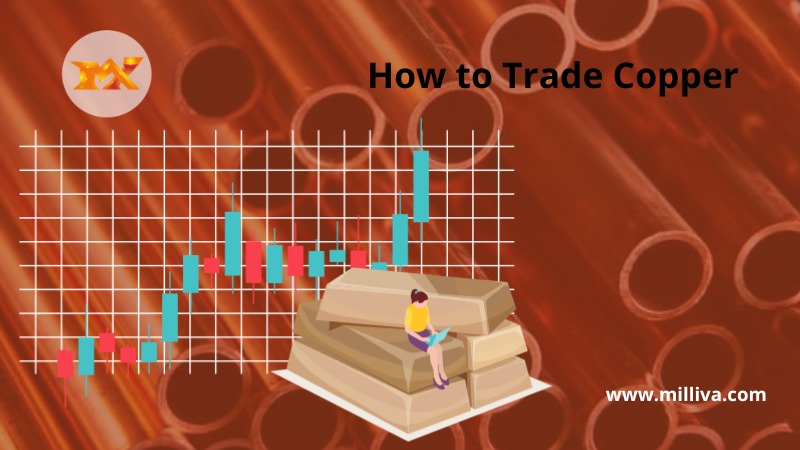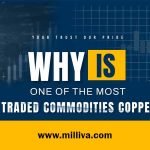What is Copper Trading

![]()
What is Copper
Copper is a ductile, malleable, reddish-gold metal that effectively conducts heat and electricity. One of the most frequently used metals today, copper was the first metal that humans worked with. Many people show inte
With other metals, copper combines well to create widely used alloys like brass and bronze. Due to its propensity to oxidise quickly, copper is regarded as a base metal. On the periodic chart, it has the atomic number 29 and the symbol Cu. The Latin aes Cyprium, which means ore from Cyprus, is the source of the name. The Bronze Age began with the discovery that copper could be alloyed with tin to create bronze.
Purpose of Copper
Coins were made with copper, gold, and silver as well. Since it is the most accessible of the three metals, its value is the lowest. Copper is now an alloy used in all American coins, and it is also present in gun metals. The majority of copper is utilised in motors and other electrical devices. Additionally, it is used in industrial equipment like heat exchangers and construction, such as piping.
Copper is incredibly ductile and transmits electricity, making it extremely useful, just like silver and gold do. But unlike precious metals, copper is more widely accessible, less expensive. Also copper is not seen as valuable enough to be used for money.
A worldwide commodity with numerous important industrial applications and a strong relationship to economic expansion is copper. Hedgers and speculators frequently utilise copper trading to guard against or profit from future price changes. Copper is a common choice within the spectrum of commodity trading. Because it may be accessed by both individuals and institutions.
What is Copper Trading
One of the most used and traded commodities in the world is copper. This valuable metal is essential to numerous sectors of the economy, including electronics, transportation, and construction, which ensures strong demand and makes it an ideal trading commodity.
You have two options for investing in copper: either purchase the actual raw material or trade the underlying asset’s current price movements.
How Copper Trading Works
Trading in copper has the benefit of being accessible. There are many ways to trade copper, including futures, options, stocks, and CFDs. Additionally, you can expose yourself to copper through exchange-traded funds (ETFs), such as the United States Copper Index Fund (CPER) or the JJCB.
Soft and malleable copper has qualities similar to those of gold and silver. The majority of its demand is derived from the manufacture of electrical goods, transportation machinery, and buildings.
It trades in huge quantities, which is excellent for traders since it can result in lower spreads and possibly cleaner chart patterns. It is a strong conductor of electricity and heat and has a variety of industrial uses.
Copper trading
Copper price changes are largely influenced by demand from developing market economies like China and India. These countries’ high copper demand during periods of economic expansion contributes to copper’s price increase. In contrast, as demand for copper declines during economic downturns, copper prices also tend to decline. When trading copper, investors need be mindful of this dynamic.
Many copper traders base their trading decisions on technical and/or fundamental research, which aids in predicting whether the price of copper will climb or decline. A trader might purchase or sell copper in an effort to make money off price changes once they are sure in their forecast. A trading strategy can assist a trader in managing risk in this way, identifying buy and sell signals in the market, and setting realistic take-profit and stop-loss levels with the goal of achieving favourable risk-to-reward ratios.

How is Copper Traded
Trading in copper allows you to profit from an investment in one of the most beneficial and sought-after commodities without having to take possession of any actual raw materials.
When you trade copper, you do so as a Contract for Difference, or CFD, in which case you just trade the underlying asset’s real-time price changes. Due to its adaptability, CFD trading enables you to make money whether copper prices are rising or falling.
What are the Various Copper Trading Methods
Physical copper: This refers to the practise of buying a physical quantity of copper and holding it as an asset until you’re ready to sell.
Copper futures: You can enter a contract where you agree on a price to pay today for an amount of copper that will be delivered at a specific date in the future if you think the price of copper will increase in the future. The objective is to subsequently sell the actual copper for more money than you spent.
CFD trading for copper enables you to trade real-time price changes without needing to purchase any actual copper. You just need to deposit a modest amount to get full exposure to the underlying trade with CFDs because they are leveraged products. Keep in mind that both gains and losses are increased because the profit or loss is determined based on the full size of the trade position.
Investment in Copper: Risks and Profits
Due to the nature of copper mining, there are inherent risks when investing in copper. Because of the capital needs, it is pricey. It necessitates businesses taking on a lot of debt, which may result in bankruptcy. Environmental and societal issues surround copper mining. A copper mine covers a huge region of land. Concerns about corporate governance result from this.
The copper miners in Chile are involved in labour struggles. Because businesses cannot afford to mine, there will probably be a slowdown in supply if the price of copper falls. The supply of copper will be slowed down by uncertain global economic activity as well because so much copper is required in construction of homes and autos. Unexpected occurrences like the pandemic can lead to mining closures and a shortage of supplies.
Copper trading
A frequently traded commodity is copper. But because there are so few businesses in the industry, there aren’t many conventional investment vehicles for copper. A less dangerous option is to invest in an applicable ETF or exchange-traded note. Even then, knowledge of the copper market is essential.
Investing in copper has advantages despite the risks. Due to the world’s economic recovery and the numerous applications for copper in the construction and housing sectors as well as numerous consumer industries, demand is expected to soar globally.
The demand for copper will rise as we use more renewable energy sources and switch to electric vehicles. China will continue to be a significant copper importer as it develops.
Individual investors can diversify their portfolios by using copper. Despite being rare, it is less expensive than gold and silver. It gives you a means to invest more cheaply and enter the market for semi-precious metals. Copper, on the other hand, is not a countercyclical metal like gold. On the other hand, copper is cyclical and fluctuates along with the larger market.

Visit us on: www.milliva.com





